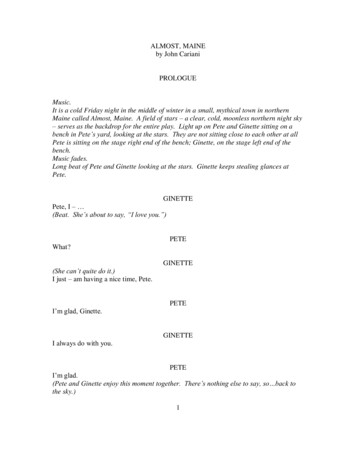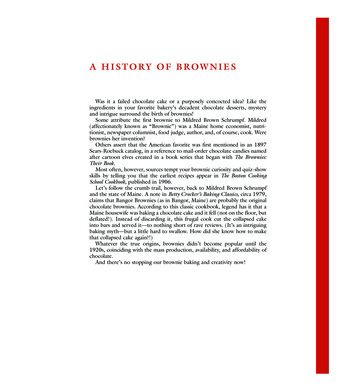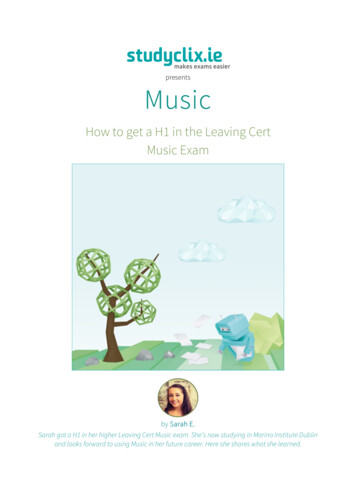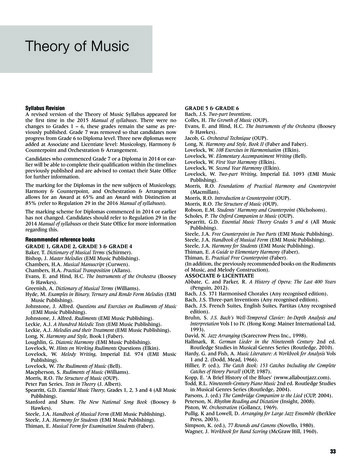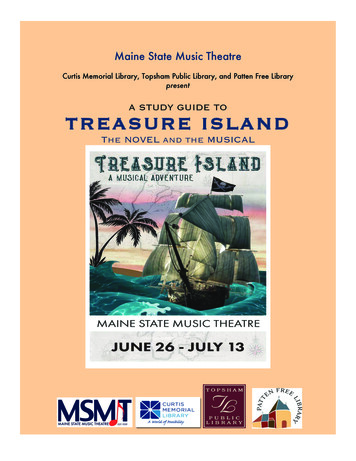
Transcription
Maine State Music TheatreCurtis Memorial Library, Topsham Public Library, and Patten Free LibrarypresentA STUDY GUIDE TOTREASURE ISLANDThe NOVEL and the MUSICAL
2STUDY MATERIALSTREASURE ISLAND: THE NOVELRobert Louis StevensonPage 3Treasure Island in Literary HistoryPage 5Fun Facts About the NovelPage 6Historical Context of the NovelPage 7Adaptations of Treasure Island on Film and StagePage 9Treasure Island: ThemesPage 10Treasure Island: Synopsis of the NovelPage 11Treasure Island: Characters in the NovelPage 13Treasure Island: GlossaryPage 15TREASURE ISLAND A Musical Adventure: THE ROBIN & CLARK MUSICALArtistic StatementPage 18The Creators of the MusicalPage 19Treasure Island A Musical Adventure: ThemesPage 20Treasure Island A Musical Adventure: Synopsis & SongsPage 21Treasure Island A Musical Adventure: Cast of CharactersPage 24Treasure Island A Musical Adventure: World PremierePage 26Press QuotesPage 27QUESTIONS FOR DISCUSSIONPage 28MSMT’s Treasure Island A Musical AdventurePage 29
3TREASURE ISLAND: THENOVELROBERT LOUIS STEVENSONRobert Louis Balfour Stevenson wasborn in Edinburgh, Scotland, onNovember 13, 1850, to Thomas andMargaret Stevenson. Lighthousedesign was his father's and his family'sprofession, so at age seventeen, heenrolled at Edinburgh University tostudy engineering, with the goal offollowing in the family business.Lighthouse design never appealed toStevenson, though, and he beganstudying law instead. His spirit ofadventure truly began to appear at thisstage, and during his summervacations he traveled to France to bearound young writers and painters. Heemerged from law school in 1875, butdid not practice, as, by this point, hefelt that his calling was to be a writer.Stevenson slowly moved away fromhis upbringing, adopting more Bohemian dress and declaring himself an atheist.In 1878, Stevenson saw the publication of his first volume of work, An Inland Voyage; the bookprovides an account of his trip from Antwerp to northern France, which he made in a canoe via theRiver Oise. A companion work, Travels with a Donkey in the Cevennes (1879), continues in thisintrospective vein, but also focuses on the voice and character of the narrator, beyond simply telling atale.Also from this period are the humorous essays of Virginibus Puerisque and Other Papers (1881),which were originally published from 1876 - 1879 in various magazines, and Stevenson's first book ofshort fiction, New Arabian Nights (1882). The stories marked the United Kingdom's emergence intothe realm of the short story, which had previously been dominated by the Russians, Americans andFrench. These stories also marked the beginning of Stevenson's adventure fiction, which would cometo be his calling card.A turning point in Stevenson's personal life came in September 1876 when he met Fanny Osbourne.She was a thirty-six-year-old American who was married (although separated) and had two children.Stevenson and Osbourne began to see each other romantically while she remained in France. In1878, she divorced her husband, and Stevenson set out to meet her in California (the account of hisvoyage would later be captured in The Amateur Emigrant). The two married in 1880, and remainedtogether until Stevenson's death in 1894.After their wedding, the Stevensons took a three-week honeymoon at an abandoned silver mine inNapa Valley, California, and it was from this trip that The Silverado Squatters (1883) emerged. Also
4appearing in the early 1880s were Stevenson's short stories "Thrawn Janet" (1881), "The Treasureof Franchard" (1883) and "Markheim" (1885), the latter two having certain affinities with TreasureIsland and Dr. Jekyll and Mr. Hyde.The 1880s were notable for both Stevenson's declining healthand his prodigious literary output. He suffered fromhemorrhaging lungs (likely caused by undiagnosedtuberculosis or sarcoidosus), and writing was one of the fewactivities he could do while confined to bed. While in thisbedridden state, he wrote some of his most popular fiction,most notably Treasure Island (1883), Kidnapped (1886),Strange Case of Dr. Jekyll and Mr. Hyde (1886), and TheBlack Arrow (1888).The idea for Treasure Island was ignited by a map thatStevenson had drawn for his 12-year-old stepson; Stevensonconjured up a pirate adventure story to accompany thedrawing, and it was serialized in the boys' magazine YoungFolks from October 1881 to January 1882. When TreasureIsland was published in book form in 1883, Stevenson got hisfirst real taste of widespread popularity, and his career as aprofitable writer had finally begun. The book was Stevenson'sfirst volume-length fictional work, as well as the first of hiswritings that would be dubbed "for children." By the end of the 1880s, it was one of the period's mostpopular and widely read books.The year 1886 saw the publication of Strange Case of Dr. Jekyll and Mr. Hyde, which was animmediate success and helped cement Stevenson's reputation. The work is decidedly of the "adult"classification, as it presents a jarring and horrific exploration of various conflicting traits lurking withina single person. The book went on to international acclaim, inspiring countless stage productions andmore than 100 motion pictures.In June 1888, Stevenson and his family set sail from San Francisco, California, to travel the islands ofthe Pacific Ocean, stopping for stays in Hawaii. In 1889, they arrived in the Samoan islands, wherethey decided to build a house and settle. The island setting stimulated Stevenson's imagination, andinfluenced his writing during this time. Several of his later works are about the Pacific isles, includingThe Wrecker (1892), Island Nights' Entertainments (1893), The Ebb-Tide (1894) and In the SouthSeas (posthumously in 1896).Toward the end of his life, Stevenson's South Seas writing included more of the everyday world, andboth his nonfiction and fiction became more powerful than his earlier works. These more matureworks not only brought Stevenson lasting fame, but they also helped to enhance his status with theliterary establishment when his work was re-evaluated in the late 20th century, and his abilities wereembraced by critics just as his storytelling had always been by readers.Robert Louis Stevenson died of a stroke on December 3, 1894, at his home in Vailima, Samoa. Hewas buried at the top of Mount Vaea, overlooking the sea.
5TREASURE ISLAND IN LITERARY HISTORYTreasure Island was originally serialized in the children's weeklyYoung Folks Magazine in seventeen weekly installments from1881 through 1882 under the title Treasure Island, or the Mutinyof the Hispaniola, credited to the pseudonym "Captain GeorgeNorth." It was first published as a book on 14 November 1883,by Cassell & Co., London.Stevenson had conceived the idea of Treasure Island (originallytitled, The Sea Cook: A Story for Boys from a map he idly drewfor his stepson of an imaginary, romantic island on a rainy dayin Braemar, Scotland. Stevenson had just returned from his firststay in America, with memories of poverty, illness, andadventure (including his recent marriage), and a warmreconciliation between his parents had been established.Stevenson’s father contributed a number of suggestions to thework. Stevenson envisioned his tale as a coming of age story forboys. Completing fifteen chapters in as many days, theserialized work was designed for a public that embraced reading as an entertaining pastime.Two general types of sea novels were popular during the 19th century: the navy yarn, which places acapable officer in adventurous situations amid realistic settings and historical events, and the desertisland romance, which features shipwrecked or marooned characters confronted by treasure-seekingpirates or angry natives. Treasure Island was a climax of this second genre which had roots in DanielDefoe’s Robinson Crusoe and Sir Walter Scott’s The Pirate.The publication of the novel in book form as Treasure Island proved to be Stevenson's first financialand critical success, winning a wide readership and such prominent fans as British Prime MinisterWilliam Gladstone.The original manuscript of Treasure Island is lost, perhaps havingbeen sold at auction by the Stevenson heirs in 1918. Numerouseditions of the book succeeded the 1882 first printing, including somewhich were handsomely illustrated by leading artists of the day, suchas George Roux with his first set of drawings in the style of Hogarthin 1885, the N.C. Wyeth 1911 edition with its iconic, romanticized fullcolor plates, Louis Rhead’s 1915 art nouveau plates, or the MervynPeake 1949 edition with its dark, psychological pen and ink drawings.
6FUN FACTS ABOUT TREASURE ISLAND Long John Silver was based on Stevenson’s friend WilliamHenley who had lost his leg as a complication of tuberculosis.Stevenson said he imagined Henley “deprived of all his goodcharacteristics” to create the darker Silver. There are allusions to several real-life pirates, includingBlackbeard, William Kidd, and Bartholomew Roberts. IsraelHands, one of Silver’s men, who dies a bloody death at thehands of Jim Hawkins, was the actual name of Blackbeard’ssecond in command. Treasure Island also references Britishnaval officers on the other side of the fight, like Admiral JohnBenbow. A number of touches were borrowed from other writers of thetime: Flint’s skeleton from Edgar Alan Poe and Billy Bones’ history from Washington Irving, forexample. There are Treasure Island and Peter Pan (J. M. Barrie) connections: Long John Silver ismentioned in Peter Pan and Wendy as the only man Captain Hook fears, while in Disney’sTreasure Island movie, Bobby Driscoll, who plays Jim Hawkins, went on to serve as voice foranimated Peter in Disney’s Peter Pan movie. The violence in the story was shocking for theperiod. Readers have long puzzled over actual location ofthe island; some details suggest a place along theSpanish Main, but others such as the rattlesnake orsea lions do not fit. Rather, the island seems acompendium of ideas created from Stevenson’simagination. There are more than fifty film and televisionadaptations of the novel.
7HISTORICAL CONTEXT OF THE NOVELBRITAIN IN THE AGE OF SAILIn 18th century England, as she had since the days of the Spanish Armada, Britain ruled the highseas. Her Royal Navy and merchant fleets advanced the nation’s interests in trade, colonialacquisition, and military supremacy. Treasure Island is set in the mid-18th century, an era of tall,wooden sailing ships, voyages to the New World, real battles with pirates, and danger of impressmentof sailors by Royal Navy or pirate crews. The subsequent Napoleonic Wars saw the British Navyreassert its dominance in famous sea battles like Trafalgar.Life at sea could be harsh, voyages long and dangerous, food primitive by modern standards, anddiscipline severe. Sailors generally went to sea as boys. By the time they were sixteen they could berated as seamen, and normally served at sea for another ten years, before settling down and taking ashore or local sailing job. The idea of being single, free of responsibilities and well paid would havemade a career at sea obviously alluring, but the attractions could also undoubtedly wear off, and onlya small percentage of men stayed on at sea, rising to be naval petty officers and merchantshipmasters.The press-gang was used, especially in time of war to recruit men forcibly into the Royal Navy. Itwould often impress professional seamen from the merchant service. As there were no spareseamen, however, both fleets sometimes needed the additional labor of landlubbers, attracted by thepay and opportunity, or of foreign sailors, who made up a significant proportion of all British crews.(Stevenson references the ethnic and national diversity of the Hispaniola’s crew).many to see themas simple, careless creatures.By contrast, the prime seamen, rated as Able or Ordinary, saw themselves as an elite group within avertically stratified working community. The topmen, who worked on the highest yards, spent much oftheir day aloft, in the tops, which on a man of war would be spacious areas out of sight of the officers,and far above the inferior members of the crew. They would form their own mess, a group of six toten men who cooked and ate together.To work aloft was to be among the elite of the 18th-century working class, and this was somethingthat seamen delighted in advertising through their unique and colorful clothes, hairstyles, personaljewelry and - after contact with the Polynesian societies of the South Pacific - tattooing. Thisdistinctive dress also marked them out when on shore, where their carefree, spendthrift and oftenriotous adventures led many to see them mistakenly as simple, careless creatures and figures of fun.Rather, they were professional sailors who were skilled, daring and resourceful men. Their true worthwas known to the state they served, and it was they, more than anything else, that gave Britain anupper hand at sea.
th8PIRATES IN THE 18 CENTURYWhile the so-called Golden Age of Piracy was over by 1720,piracy was still rampant in the seafaring life. That Stevensonand the Victorian era liked to look back on pirates of the 18thcentury in Romantic terms, relishing swashbuckling tales oftheir escapades, likely had to do with the increasingindustrialization of Britain and the sometimes stiflingconventions of Victorian society.Many chose the pirate life because they had lost militarypositions after the War of Spanish Succession (1713); others,especially in the Caribbean, were drawn to the tantalizingpossibility of spoils along the triangular trade route; otherswere commandeered into service when their vesselsurrendered; and still others mutinied from a British sailingvessel. All benefitted from Britain’s inability to protectcompletely all its colonial resources. But as the British Navygrew to meet the nation’s military demands, it also marshaledgreater resources to hunt down and stop piracy in its tracks.This initiative was bolstered by the severe law Britain enactedto punish captured pirates. Increasingly, the path to wealth in the Caribbean lay in peaceful trade (andsome smuggling). By the 18th century, the Bahamas had become the new colonial frontier for theBritish. The port of Nassau became one of the last pirate havens.On turning pirate, the men would adopt their own pirate code – a series of articles to which they allagreed and which provided rules for discipline, division of stolen goods, and compensation for injuredpirates. Relying on fierce loyalty, these codes were surprisingly democratic, requiring all hands toagree and elect officers. Pirates also lived a remarkably diverse and inclusive existence; theysympathized with the plight of enslaved Africans, and they attacked slave ships in the Caribbean sothey could free the captives. Black and white pirates fought and lived in equality, side-by-side.Pirate treasure was not always gold, but often more practical articles such as food and other suppliestaken from the surrendered vessel.If captured and returned to Britain, justice was swift and severe with many executed publically. Somehowever, managed to “retire” to Caribbean safe havens and take up more main stream occupationslike island governance or captaining a merchant ship.WOMEN IN THE 18th CENTURYIn general, the female domain in the 18th century was seen to be the home and hearth; women wereviewed as the weaker sex requiring the protection of fathers, brothers, or husbands, and marriagewas their prime avenue to any advancement. (Think Jane Austen!)In rural settings, women handled domestic chores and helped with home businesses and farms. Theywould also make and mend clothing for the family. Moreover, they were expected to act as familydoctors, making home remedies for sicknesses. They grew trees for herbs to cure various ailments.Single women, on the other hand, worked for a living outside the home in domestic services andvarious trades. The textile trade, catering trade, and shops employed a large number of women.
9While these norms were challenged by an heroic few and while cataclysmic events like wardisrupted these patterns, 18th century England remained a man’s world.These precepts applied to maritime life where the British Royal Navy and merchant ships forbadewomen aboard, considering them bad luck. While there were exceptions made that occasionallydefied the rules, in general, sea captains’ wives waited at home, raising the children and managingthe family assets.ADAPTATIONS OF TREASURE ISLAND on FILM and STAGETreasure Island (1934), starring JackieCooper and Wallace Beery. An MGM production, the first soundfilm version. Treasure Island (1937), a loose Soviet adaptationstarring Osip Abdulov and Nikolai Cherkasov, with a scoreby Nikita Bogoslovsky. Treasure Island (1950), starring Bobby Driscoll and RobertNewton. Notable for being the Walt Disney Studios' firstcompletely live action film. Treasure Island (1972), starring Orson Welles. Thisadaptation was produced by National General Pictures, directedby John Hough, Andrew White and John Salway. Treasure Island (1990), starring Charlton Heston, ChristianBale, Oliver Reed, Christopher Lee and Pete Postlethwaite. Amade-for-TV film written, produced and directed by Heston'sson, Fraser C. Heston. Treasure Island (1995), a made-for-TV movie directed by Ken Russell and starring HettyBaynes as Long Jane Silver. Muppet Treasure Island (1996), a film produced by The Jim Henson Company and releasedby Walt Disney Pictures, starring the Muppets. Treasure Island (1999), starring Jack Palance as Long John Silver, Patrick Bergin as BillyBones, Christopher Benjamin as Squire Trelawney and Kevin Zegers as Jim Hawkins.
10TREASURE ISLAND: THEMESStevenson’s Treasure Island is a powerful coming of age storywhich explores many universal themes, among them:The meaning of manhood: Jim Hawkins, having lost hisfather, must navigate this journey to manhood on his own. Hedoes so with the help of three surrogate fathers, Dr. Livesey,Squire Trelawney, who have his best welfare at heart and helpshape his moral compass, and Long John Silver, who provesa more ambiguous and dark influence, yet one whosepresence deeply changes Jim.The search for a father figure and role models: This questtakes Jim on a psychological adventure which parallels theswashbuckling one of his sea voyage. Ultimately, he learns toincorporate qualities from the various influential men in his lifeinto his own sense of self.Life’s moral ambiguity: All the characters often findthemselves in situations where there is not a clear distinctionbetween good and evil, and they must decide in the moment. Moreover, many of the characters, mostespecially Long John Silver, possess both dark and generous sides to their natures. Jim learns to seethe nuances of life through his adventure.Dreams versus reality: Jim has long dreamt of adventure and finding the colorful world of his seacaptain father. Dr. Livesey and the Squire are also tempted by the promise of adventure in finding Flint’streasure. So, too, are the pirates, though their quest has a more mercenary end. Jim ultimately learnsthat dreams can have a more sinister side and that adventure may be only a path to finding a fulfillingreality.Exploration: Treasure Island begins with a map, and the book is literally one of the finest examples ofadventure quest literature written, but the theme of exploration goes beyond the voyage. Understandinghuman nature, engaging with diverse and new people and perspectives are all part of the journey.Greed: For Long John Silver and the pirates, greed is the driving force, and it leads them to the violenceof their cutthroat ways. While the doctor, squire, and Jim are tantalized by the promise of riches, they donot place the treasure above their moral principles.Honor, duty, and bravery: These terms mean different things to each of the characters. Theconventional, stalwart sense of upstanding duty and moral rectitude is exemplified by Captain Smollett,but the pirates have their own code and principles. Jim must ultimately define these concepts for himself,drawing on the entire experience.
11TREASURE ISLAND: SYNOPSIS OF THE NOVELPART I—"THE OLD BUCCANEER"Jim Hawkins and his mother have just buried Captain Hawkins, and Jim finds himself fatherless andtasked with being “the man of the house,” the Admiral Benbow Inn on the West Coast of England inthe mid-18th century. An old sailor, Billy Bones, comes to lodge, paying Jim Hawkins a few pennies tokeep a lookout for "a one-legged seafaring man". A former shipmate with intact legs, but lacking twofingers, shows up to confront Billy about sharing his treasure map. After running the stranger off in aviolent fight, Billy, who drinks far too much rum, has a stroke and tells Jim that his former shipmatescovet his map to buried treasure. After a visit from an evil blind man named Pew who gives him "theblack spot" as a summons to share the treasure map, Billy has another stroke and dies; Jim and hismother unlock the sea chest to find some money, a journal, and the map. The local physician, Dr.Livesey, and the district squire, Trelawney, deduce that the map is of the island where a deceasedpirate, Captain Flint buried his treasure. Squire Trelawney proposes buying a ship and going after thetreasure, taking Livesey as ship's doctor and Jim as cabin boy.PART II—"THE SEA COOK"Several weeks later, the Squire introduces Jim and Dr. Livesey to Long John Silver, a onelegged Bristol tavern-keeper whom he has hired as ship's cook. They also meet Captain Smollett,who tells them that he is wary of most of the crew for the voyage, and of the rumored goal, a searchfor treasure. After taking a few precautions, however, they set sail on Trelawney's schooner,the Hispaniola, for the distant island. During the voyage, the first mate, a drunkard, disappearsoverboard. And just before the island is sighted, Jim—concealed in an apple barrel—overhears Silvertalking with two other crewmen. Most of them are former "gentlemen o'fortune" from Flint's crew andhave been planning a mutiny. Jim alerts the captain, doctor, and squire, and they calculate that theyare outnumbered and must pretend not to suspect anything until after the treasure is found and theycan then surprise their adversaries.PART III—"MY SHORE ADVENTURE"But after the ship is anchored, Silver and some of the others go ashore, and two men who refuse tojoin the mutiny are killed. Jim has impulsively joined the shore party and covertly witnessed Silvercommitting one of the murders; now, in fleeing, he encounters a half-crazed Englishman, Ben Gunn,
12who tells him he was marooned there and that he can help against the mutineers in return forpassage home and part of the treasure.PART IV—"THE STOCKADE"Meanwhile, Smollett, Trelawney, and Livesey, along with Trelawney's three servants and one of theother hands, Abraham Gray, leave the ship and come ashore to occupy an old abandoned stockade.The men still on the ship, led by the coxswain Israel Hands, run up the pirate flag. One of Trelawney'sservants and one of the pirates are killed in the fight to reach the stockade, and the ship's gun keepsup a barrage upon them, to no effect, until dark when Jim finds the stockade and joins them. The nextmorning, Silver appears under a flag of truce, offering terms that the captain refuses, and revealingthat another pirate has been killed in the night (by Gunn, Jim realizes, although Silver does not). AtSmollett's refusal to surrender the map, Silver threatens an attack, and, within a short while, hemakes good on his threat.PART V—"MY SEA ADVENTURE"After a battle, the surviving mutineers retreat, having lost five men, whiletwo more of the captain's group have been killed, and Smollett himself isbadly wounded. When Livesey leaves in search of Gunn, Jim runs awaywithout permission and finds Gunn's homemade little boat. After dark, hegoes out and cuts the Hispaniola adrift. The two pirates on board, Handsand O'Brien, interrupt their drunken quarrel to run on deck, but the ship—with Jim's boat in her wake—is swept out to sea on the ebb tide.Exhausted, Jim falls asleep in the boat and wakes up the next morning,bobbing along on the west coast of the island. Eventually, he boards theship, which seems deserted, but finds O'Brien dead and Hands badlywounded. He and Hands agree that they will beach the ship at an inlet onthe northern coast of the island. As the ship is about to beach, Handsattempts to kill Jim, forcing Jim to defend himself and kill Hands instead.Then, after securing the ship as best as he can, Jim goes back ashore andheads for the stockade. Once there, in utter darkness, he enters theblockhouse, only to be greeted by Silver and the remaining five mutineers,who have somehow taken over the stockade in his absence.PART VI—"CAPTAIN SILVER"Silver and the others argue about whether to kill Jim, and Silver talks them down. He tells Jim that,when everyone found the ship was gone, the captain's party agreed to a treaty whereby they gave upthe stockade and the map. In the morning, the doctor arrives to treat the wounded and sick piratesand tells Silver to look out for trouble when they find the site of the treasure. After he leaves, Silverand the others set out with the map, taking Jim along as hostage. They encounter a skeleton, armsapparently oriented toward the treasure, which seriously unnerves the party. Eventually, they find thetreasure cache, but it is empty. The pirates are about to charge at Silver and Jim, but shots are firedby Livesey, Gray, and Gunn from ambush. One pirate is killed and another, George Merry, wounded,and then quickly killed by Silver. The other three run away, and Livesey explains that Gunn hadalready found the treasure and taken it to his cave.In the next few days, they load much of the treasure onto the ship, abandon the three remainingmutineers (with supplies and ammunition), and take Silver on board to return to England for trial.They sail away to their first port in Spanish America, where they will sign on more crew. Silver stealsa bag of money and escapes. The rest sail back to Bristol and divide up the treasure. Jim says thereis more left on the island, but he has had his fill of adventure and will not undertake another voyage torecover it.
13TREASURE ISLAND: CHARACTERS IN THE NOVEL Jim Hawkins: The first-person point of view, ofalmost the entire novel. Jim is the twelve-year-old son of asea captain and an innkeeper near Bristol, England. Hedreams of adventure, and the quest for the treasurebecomes his coming of age journey. Dr. David Livesey: The local doctor and magistrate.Dr. Livesey is wise and practical, and serves as Jim’sguardian and protector. As his name suggests, Liveseyrepresents the steady, modest virtues of everyday life ratherthan fantasy, dream, or adventure, but he does impart astrong sense of moral compass to Jim. Long John Silver: The ship’s cook, the one-leggedSilver is the secret ringleader of the pirate band. Greedy,capable of violence to achieve his ends, he is, at the sametime, always kind toward Jim and genuinely fond of the boy.Silver is a powerful mixture of charisma and selfdestructiveness, individualism and recklessness Captain Alexander Smollett: The captain of theHispaniola, Captain Smollett is the quintessential honorableBritish sea captain, who is motivated by a strict moral codeand believes in uncompromising justice.Squire John Trelawney: A local wealthy landowner, Trelawney arranges the voyage to the islandto find the treasure. Trelawney is naïve and easily tricked by the pirates.Billy Bones: The old seaman who resides at Jim's parents' inn, Billy, used to be Flint's first mate.His sea chest and treasure map set the whole adventure in motion.Blind Pew: A vicious, deadly, sinister blind beggar who served as a member of Flint's crew, hedelivers the Black Spot, the pirate curse, to Billy Bones. He is then trampled to death by thehorses of revenue officers riding to assist Jim and his mother.Alain: A sailor who does not mutiny. He is killed by the mutineers for his loyalty, and his dyingscream is heard across the island.Allardyce: One of the six members of Flint's Crew who, after burying the treasure and silver andbuilding the blockhouse on Treasure Island, are all killed by Flint. His body is lined up by Flint as acompass marker to the cache.Job Anderson: The ship's boatswain and one of the leaders of the mutiny, he participates in thestorming of the blockhouse and is killed by Gray as he tries to attack Jim.Mr. Arrow: The first mate of the Hispaniola, is an alcoholic and is useless as a first mate. Hedisappears before they get to the island, and his position is filled by Job Anderson.Black Dog: Formerly a member of Flint's pirate crew, he is later one of Pew's companions whovisits the Admiral Benbow to confront Billy Bones.Mr. Dance: Chief revenue officer who converges with his men upon the Admiral Benbow, drivingout the pirates, and saving Jim Hawkins and his mother. He then takes Hawkins to see the squireand the doctor.Captain Flint: John Flint, the fictional pirate Captain of the Walrus. After robbing and lootingtowns and ships among the Spanish Main, in August 1750, he took six of his own crew ontoTreasure Island. After building a stockade and burying the bulk of his looted treasure, he killed allsix men. In July 1754, he died at Savannah, Georgia, of cirrhosis, caused by drinking too much
14 rum. On his deathbed, he gives his treasure map to Billy Bones. Long John Silver's parrot isnamed after Captain Flint.Abraham Gray: A ship's carpenter on the Hispaniola, he is almost incited to mutiny but remainsloyal to the Squire's side when asked to do so by Captain Smollett, he saves Hawkins' life bykilling Job Anderson during an attack on the stockade, and he helps shoot the mutineers as theyrifle the treasure cache. He later escapes the island toge
4 appearing in the early 1880s were Stevenson's short stories "Thrawn Janet" (1881), "The Treasure of Franchard" (1883) and "Markheim" (1885), the latter two having certain affinities with Treasure Island and Dr. Jekyll and Mr. Hyde. The







